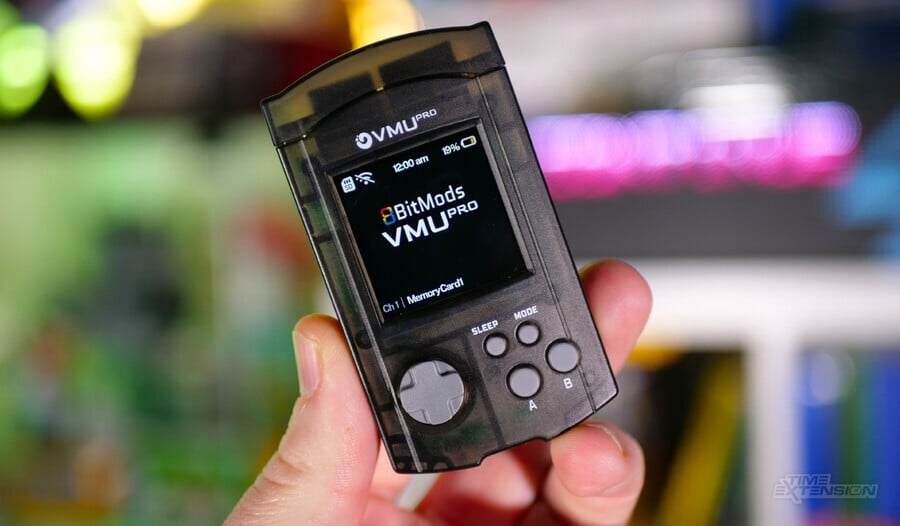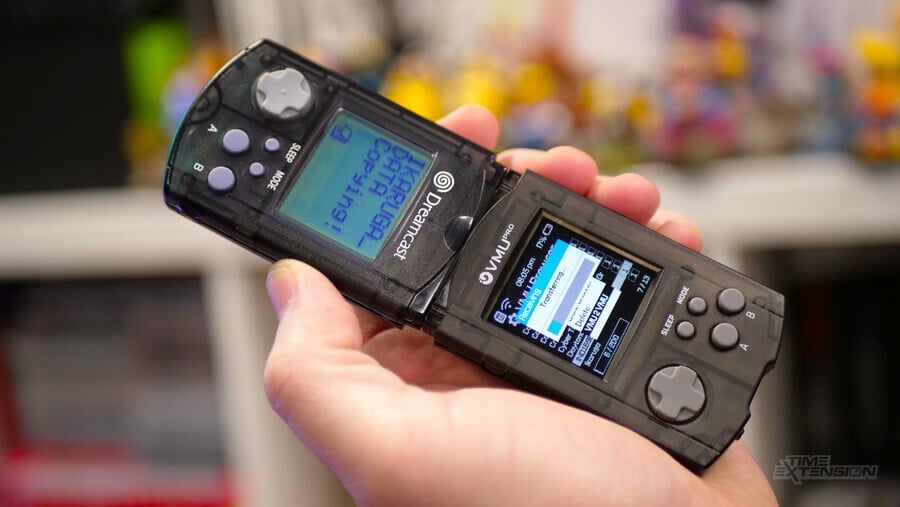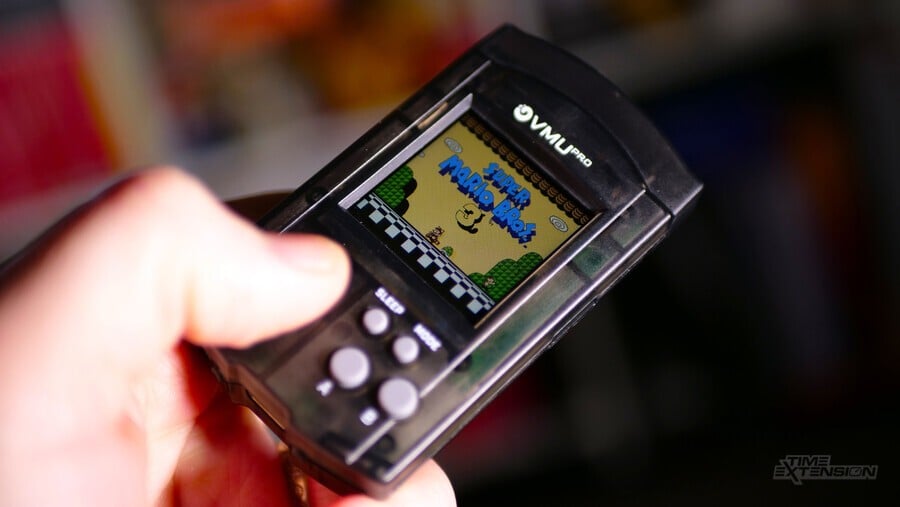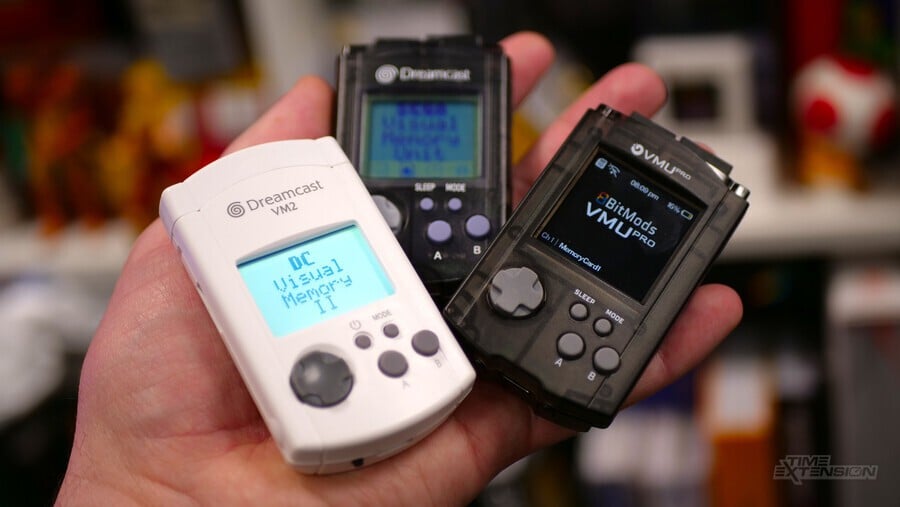
Before internal storage became the norm, Sega blazed a trail with the Dreamcast Visual Memory Unit, a pocket-sized device which not only stored all of your game progress but also doubled as a tiny handheld game console.
One of the Dreamcast's more unique features, the VMU felt like a genuine innovation – but it had some serious shortcomings. Storage space wasn't great, which meant that serious collectors would either need to delete progress to free up space or invest in multiple VMUs.
Another drawback was that the internal CR2032 batteries didn't last all that long and weren't rechargeable, which led to the annoying 'beep' sound whenever you turned on your console with a 'dead' VMU inserted into the controller. Many serious Sega fans have this abrasive, discordant noise etched into their psyche.
The VMU was definitely a flawed masterpiece, then, but we've recently seen the modding community fix its shortcomings. We've already been blessed with the excellent DreamMods VM2, but 8BitMods has produced what, on paper, at least, is an even more impressive upgrade: the VMU Pro.
8BitMods VMU Pro Review: Design, Build & Battery

While the VMU Pro and VM2 share the same basic functionality – they are 'next generation' Dreamcast memory cards capable of storing almost unlimited amounts of save game data thanks to the use of MicroSD media – 8BitDo's offering boasts some significant advantages over DreamMods' VM2.
The most notable feature is the 1.5-inch 24-bit colour IPS TFT display, which boasts a resolution of 240x240 pixels. Not only does this enhance the user interface's appearance, but it also enables other interesting features – one of which is emulation, which we'll cover shortly.
Unlike the VM2, which is a fairly close match to the original VMU in terms of aesthetics, 8BitMods has designed the VMU Pro with a reasonably unique case design. I'm not sure it feels as 'solid' as the official VMU or VM2, but that could be my tactile memory politely objecting to the fact that it feels slightly different in the hand.
It features all the usual hallmarks of a VMU – a D-pad, A and B buttons, 'Sleep' and 'Mode' buttons – as well as two additional buttons located at the bottom of the unit, with the USB-C port separating them. The top of the unit features the 'Maple' connector, which not only interfaces with your Dreamcast controller but also enables data transfer between the VMU Pro and other devices, such as the VM2 and a standard VMU.
The two extra buttons located at the bottom of the VMU Pro enable you to switch between virtual VMUs when the device is docked in your controller, rendering the other controls inaccessible. Pressing the right-hand button (which, when the VMU Pro is connected to your controller and upside down, becomes the left-hand button) brings up a VMU browser. The right-hand button allows you to confirm your selection. Exiting the browser is achieved by pressing both buttons simultaneously.
The VMU Pro is powered by an internal 720mAh Lithium-Polymer rechargeable battery, which allows the device to remain in deep-sleep mode for a whopping 750 hours, according to 8BitMods. This can either be charged when the device is docked or topped up using a USB-C cable. If you power off the device completely, the battery shouldn't drain at all.
During actual usage, the battery lasts for around six hours, but that's very much a 'best-case' scenario; you need to turn WiFi off and have the brightness and volume set very low. A more accurate runtime would be between three and four hours, in my experience, with WiFi on and both the brightness and volume at higher, more acceptable levels.

8BitMods VMU Pro Review: UI & Software Features

It's worth delving a little deeper into what makes the VMU Pro stand out when compared to both the standard VMU and the VM2. Unlike DreamMods' option, the VMU Pro requires a MicroSD card to function (the VM2, you might recall, could act like a standard, 200-block memory unit even if an SD card was not present).
The first time you boot up the device, another obvious selling point becomes apparent – the VMU Pro prompts you for your WiFi details. This device is not only capable of downloading firmware updates from the cloud, but it also allows you to upload your save data to your Google Drive account, keeping your progress safe in the event that your VMU Pro goes missing while you're on the road. In the fullness of time, you'll also be able to transfer data between multiple VMU Pros using WiFi (that's coming in a future firmware update, according to 8BitMods).
Like the VM2, the VMU Pro comes with GameID support, which means it can recognise the game you're playing when it's being loaded via an Optical Drive Emulator, like the Terraonion MODE. The VMU Pro creates a virtual memory card for each game you play, rather than lumping together multiple games on a single card (as is the case with an official Dreamcast VMU). It might seem wasteful, but given that just 1GB equals around 8192 virtual memory cards, this approach actually makes a lot of sense.
The VMU Pro then automatically finds and loads the game's unique virtual memory card the next time you boot up the title in question. Furthermore, you can have extra 'channels' per virtual memory card, which effectively means you can have multiple VMUs for the same game.
If you're not using an ODE, the 'DisplayID' system allows the VMU Pro to recognise the game you're playing via the image displayed on the VMU's screen. I didn't get a chance to test this as my Dreamcast has a MODE installed and there's no optical drive present, but 8BitMods admits it's not 100% accurate.
The VMU Pro features its own custom UI for browsing save game data, presenting information in a far more visually appealing manner than the VM2, which is limited by its monochrome display. The VMU Pro is able to replicate the colour save data icons which you usually only see when you're exploring the VMU via the Dreamcast's frontend – a really lovely touch. You can copy or delete data from the VMU Pro UI itself, which is very handy.
Handling Dreamcast save data is just one aspect of the VMU Pro, as we've already established. The device is capable of hosting its own native games, and 8BitMods has even created an SDK to facilitate this. Additionally, an online portal for downloading games will be created. I wasn't able to test any of this as none of it is available yet.
There's a raft of other options available when you're browsing the VMU Pro's UI, including the ability to alter the volume of the built-in speaker, change the screen brightness, swap the functionality of the A and B buttons and much, much more.
8BitMods VMU Pro Review: Emulation & MP3 Playback

The device is capable of playing Game Boy, Game Boy Colour, NES, Master System and Game Gear titles, all at 60fps. You also get save state support, which is a nice touch. Because the VMU Pro is supplied without a MicroSD card, you'll need to download all of the emulators yourself, and it goes without saying that ROMs will need to be sourced from somewhere, too.
In terms of performance, things run pretty well. I noticed some graphical issues when playing Zelda on the NES emulator, and the pixel scaling for Game Boy games makes things look a little muddy, but otherwise, the VMU Pro's dual-core 240MHz CPU is more than capable of replicating these systems without any major issues.
A more pressing concern is the fact that the VMU Pro's D-pad and buttons aren't the ideal interface for playing intense games like Mega Man 2 or Alex Kidd in Miracle World; the D-pad feels cheap and floaty, for example. Having said that, titles like Tetris or Mole Mania are quite playable despite the shortcomings of the interface, and I could certainly see myself wasting a few minutes each day with this device – assuming I didn't have a better gaming option to hand, of course.
The same could be said of the VMU Pro's other party trick: MP3 playback. You can either play the audio via the device's 0.7-watt mono speaker or hook up some headphones.
I tried my USB-C to 3.5mm headphone lead to connect a pair of Apple headphones, and it worked well enough – but again, it all depends on what other choices you have available. I can't imagine many people choosing to listen to music via this method when they have a smartphone to hand, but it's nice to have the option, nonetheless.
8BitMods VMU Pro Review: Summary

For the most part, then, the VMU Pro performs its duties well and offers some neat bonus features which elevate it above the competition. However, like the VM2 – which has matured into a really solid piece of kit thanks to a series of regular firmware updates – the VMU Pro at launch shouldn't be considered the 'finished' product.
During my review period, the unit froze on me multiple times, forcing a complete restart by inserting a needle in the reset hole on its right-hand side. I also encountered an issue where the VMU Pro would remain stuck in 'upside down' mode (when it thinks it is still docked in the controller, even though it isn't), and this, too, required a hard reset to recover.
It's currently only possible to have a single WiFi network stored in the VMU Pro's memory, which creates an issue for me when I'm moving between my home and the Hookshot Media office. Additionally, I couldn't find a way to connect to a new wireless network without factory resetting the entire device. Hopefully, these are points that 8BitMods can address with an update.
I also encountered some quirks with the VMU Pro's charging system when connected to a controller. According to 8BitMods, the VMU Pro requires at least 15 seconds to start charging when docked. This is because the battery is continuously monitored through two on-board battery monitoring circuits, which check current and voltage measurements. Should the initial measurement attempt fail, the VMU Pro will retry three more times, with each test separated by 10 seconds.
This system worked flawlessly with my standard Dreamcast controller, the official Dreamcast arcade stick and Retro Fighters' wireless StrikerDC pad. However, with the wired variant of the StrikerDC, the VMU Pro refused to charge. I've spoken to 8BitMods about this, and they confirmed that it's a known issue, with a fix apparently in the works.
Indeed, it's worth noting that 8BitMods has made it clear that future firmware updates will address any bugs and introduce new features – such as the VMU Pro-to-VMU Pro wireless transfer – on the horizon.
So, there's room for improvement, then – but even at this stage, the VMU Pro is a solid best memory card option for your Dreamcast, and offers some amazing improvements over the standard version. If you're an early adopter, it's worth noting that some elements of its software may be a bit rough around the edges, at least in the short term, but it's still highly recommended, and another hit from 8BitMods.
Please note that some external links on this page are affiliate links, which means if you click them and make a purchase we may receive a small percentage of the sale. Please read our FTC Disclosure for more information.
